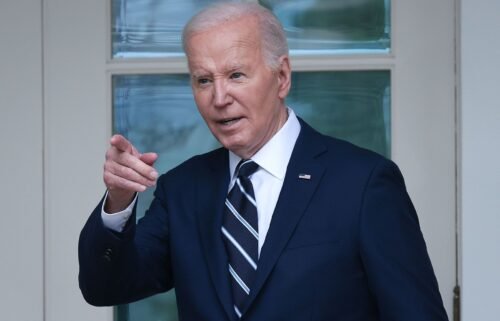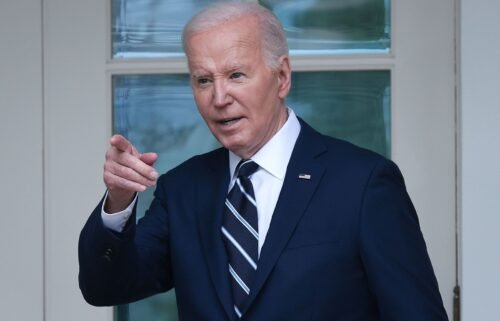Trump administration pushes ‘midnight regulations’ after breaking records for final-year rulemaking
President Donald Trump’s political appointees are finalizing an array of last-minute federal regulations ahead of Joe Biden’s inauguration, including rules that would make it harder to enforce environmental protections, tighten immigration, remove penalties for killing birds, and possibly eliminate food assistance for millions of Americans.
The Trump administration has already finalized more federal rules in its last year than any other recent President. And that’s not even counting the regulatory activity underway since Nov. 1, a period when outgoing administrations tend to rush through “midnight regulations.”
A record 111 economically significant final rules were either reviewed or completed this year through Nov. 1, according to CNN analysis of federal regulation data. Another eight have been finalized since then.
Fifteen remain pending under review, almost half of which have been submitted since Election Day, according to data as of Dec. 1 from the Office of Information and Regulatory Affairs.
Federal rulemaking is a key power held by the executive branch. While Congress passes legislation that becomes law when signed by the president, it’s up to the executive branch to interpret and implement these laws through regulations. Federal agencies submit proposed rules for review when they’re deemed “significant.” That process can often be lengthy, though there are shortcuts, such as limiting the time for public comment. A rule doesn’t take effect until after it is finalized and published in the Federal Register.
There’s precedent for such “midnight regulations.” According to the George Washington University Regulatory Studies Center, every outgoing president since Jimmy Carter has made a similar push to finalize new rules in the final lame-duck months of their administrations. Since then, each subsequent president has implemented the most regulations in their final year, many in the “midnight” phase between Election Day and the inauguration of the new incoming president.
Administrations have gotten better about waiting until the last minute. More than half of the significant final rules the Clinton administration completed in its last year were approved in its “midnight” phase. Midnight rules fell to 42% of final rules completed in George W. Bush’s last year and then fell again to 38% under Barack Obama.
Trump still has time to finalize more regulations before Biden takes office. So far only 17% of his administration’s final-year rules were finished or remain under review since the election.
Among the rules recently finished by the Trump administration is one that expands possible execution methods to include electrocution and death by firing squad, which is scheduled to go into effect in late December. In some cases, as ProPublica has reported, the administration has taken shortcuts, like reducing the amount of time for public review.
Rushing the process could make the rules more vulnerable to legal challenges.
“If they’re poorly done, they’ll be more susceptible to being overturned,” Susan Dudley, the director of the George Washington University Regulatory Studies Center said. A number of Trump administration rules that were finalized remain in court, where the administration has failed to successfully defend the majority of its policy changes, according to the Institute for Policy Integrity.
“Trump hasn’t done very well, even when the Trump Justice Department is defending him,” Dudley added. “So, you can only imagine how well (his policies will) do when it’s the Biden Justice Department defending a Trump rule.”
A new president can stop any impending final rules from being enacted on day one by halting their publication in the Federal Register. Anything pending can be withdrawn by the new agency heads.
While it’s harder for a new administration to undo final rules, it is possible. Congress can also step in to nix final rules published in the last months of the Trump administration.
Republicans were able to use the Congressional Review Act when they held both chambers of Congress to rescind more than a dozen Obama-era rules. But if Republicans maintain control of the Senate, Biden’s use of the CRA to rescind Trump era rules will be limited.
Here are some of the most notable federal rules the Trump administration is attempting to finish before Biden takes office.
The Environment
The US Fish and Wildlife Service proposed a rule in February that would remove penalties for accidentally killing a bird, potentially shielding companies from big fines. The agency is expected to make its final decision by the end of December.
On November 16, the Department of Energy sent to the White House a rule it proposed in August to loosen water efficiency standards for showerheads, days after Trump publicly complained about weak water flow in the shower.
The rule would change the definition of a showerhead and is opposed by conservation, consumer groups, utility companies and manufacturers.
A separate rule that would loosen energy conservation standards for washers and dryers was also sent to the White House for final review in November. It’s also opposed by conservation groups and manufacturers.
Two rules from the Environmental Protection Agency are awaiting final approval. Both would make it harder for the agency to use science as the main determining factor in the rulemaking process.
The first would require a cost-benefit analysis for any proposed policy changes under the Clean Air Act, regardless of whether the environmental impacts outweigh the potential economic ones, which could have significant long-term effects on policymaking at the agency.
The rule would also prevent scientists at the agency from presenting co-benefits of a proposed policy change. So, if scientists propose a crackdown on o-zone levels and that decreased amount also reduces other kinds of emissions, those co-benefits will no longer be considered when evaluating if the rule change should become policy or not.
“It’s forced the EPA to present a more narrow type of analysis that therefore makes the benefits seem smaller too,” said Brett Harti, government affairs director at the Center for Biological Diversity, an environmental advocacy group.
The “Strengthening Transparency in Regulatory Science” rule, also known as the “secret science” rule would change agency policy mandating that any underlying scientific study used to support a policy change must have publicly available raw data.
Raw data is often not allowed to be released to the public because it contains personal identifying information.
Dr. Tom Sinks, former director of the EPA Office of the Science Advisor, published a dissenting opinion about the secret science rule in August, a month before he retired. Sinks told CNN he believes the proposed rule is attempting to provide a solution to a problem that doesn’t exist.
“Now we are suddenly creating a regulation that implies, one, science is being held secret, which it isn’t, and, two, we’ll do a better job in rulemaking if we make the underlying data available, when, one, there is no evidence a problem exists and, two, there’s no evidence a problem will be solved,” Sinks said.
Sinks also said the EPA does not currently have a system where these kinds of datasets from outside research can be stored and made publicly available, which will make the implementation of the rule, if finalized, extremely difficult.
Immigration
Since Election Day, the Department of Homeland Security and other agencies have been working to finalize several rules related to student visas, work permits and the repatriation of asylum seekers to Central America.
So-called Asylum Cooperative Agreements, initiated last year, marked a significant shift in US asylum policy and forced migrants who may have legitimate claims for asylum to make their cases from other countries. The US is in various stages of agreements with the Northern Triangle countries of Guatemala, El Salvador and Honduras to host asylum seekers. Only its agreement with Guatemala was ever really up and running.
DHS also proposed a rule in November that bars undocumented immigrants who are ordered to be removed from the US from receiving work permits.
There has also been a major push to finalize a rule that takes aim at international students, potentially limiting the length of time students and others can remain in the United States.
Health Care
The Department of Health and Human Services proposed a rule the day after the election that would automatically expire any regulation after 10 years if it isn’t reviewed by the agency. And all decade-old regulations already on the books would need to be reviewed by 2023, or they would expire.
HHS estimates this would require up to 91 full-time staff positions, at a cost of up to $26 million over 10 years to implement.
According to the left-leaning Center on Budget and Policy Priorities, sunsetting HHS regulations through the proposed rule “would divert key resources from responding to COVID-19; wreak havoc on the administration of Medicaid, Medicare, the marketplaces, and other HHS programs; and potentially seriously harm millions of people.”
“A federal agency sunsetting its own regulations on this scale would be unprecedented, and this would apply to a few thousand regulations, or more,” said Dan Bosch, a regulatory expert at the conservative American Action Network. “But agencies are supposed to do this anyway. They’re supposed to review their old rules to make sure we’re getting the benefits we were expecting.”
In late November, the Centers for Medicare and Medicaid Services proposed a rule that would allow states to set up their own Affordable Care Act insurance portals with private providers, instead of using the federal exchange, Healthcare.gov. The agency last month granted Georgia permission to do so, starting in 2023.
Both of these rules are in the proposal stage and may not be finalized by Biden’s inauguration. The sunset rule is still in public comments through January. For the CMS rule, the comment period has been shortened by 30 days.
The Trump administration has also just imposed a controversial new rule changing how Medicare reimburses physicians for some expensive prescription drugs. HHS first outlined a similar proposal in October 2018, and then the President included it in an executive order in July. The rule was added to the Federal Register last week.
The administration says its goal is to lower drug prices by having Medicare pay the same rates for these drugs as other developed countries — a process known as “most-favored-nation” price.
HHS cited the Covid-19 pandemic to rush the rulemaking process and implement these changes after the election, even before seeking public comment.
“We’re now eight months after the coronavirus emergency began, and now all of a sudden, it’s an emergency, right after they happened to lose the election,” Bosch said. “It was troubling how they went about issuing that rule. I think it’ll be challenged in court and probably won’t survive.”
The Pharmaceutical Research and Manufacturers of America and three other trade groups filed a lawsuit Friday in the US District Court in Maryland challenging the legality of the Most Favored Nation rule. One of their complaints is that CMS failed to follow required rulemaking procedures.
In conjunction with that rule, officials also rolled out a second rule that will effectively ban drug makers from providing rebates in Medicare and Medicaid plans. Instead, drug companies will be encouraged to pass the discounts to patients at the pharmacy. The administration had backed down from issuing this rule last year after it was found to raise costs for seniors and the federal government. This rule was added to the Federal Register on November 30.
Another proposed HHS rule in its early stages of review, but which has moved forward since Election Day, would codify the agency’s 2019 policy banning the use of fetal tissue from abortions for federally funded research.
The Social Safety Net
The Department of Housing and Urban Development is trying to finalize a proposed rule that would let federally funded homeless shelters send transgender Americans to separate facilities, or areas within a shelter, that corresponds to their biological sex and not their gender identity.
The Trump administration justified the proposal by saying it would “better accommodate religious beliefs of shelter providers.” But transgender rights advocates say this policy would swing open the door for discrimination, and that it even puts people’s lives at risk. Transgender people are disproportionately likely to face homelessness and to be attacked while in a homeless shelter.
During the public comment period LGBTQ groups mobilized to flood HUD with thousands of comments said Rodrigo Heng-Lehtinen, deputy executive director of the National Center for Transgender Equality.
“We think we’ve stalled the clock just enough to stop HUD from finalizing this,” Heng-Lehtinen said. “Even if they finalize it, we’ve been working with the Biden transition to make sure Biden’s HUD repeals this just as quickly. We hope the Biden administration will clean it right back up.”
Another rule that’s under consideration is from the Department of Agriculture and would tighten the rules governing who qualifies for food stamps, a move that could strip more than 3 million people of their benefits and leave nearly 500,000 children without access to free school meals, according to the USDA. It was proposed in July 2019.




